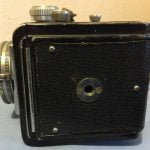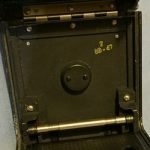Ansco made two variations of their Automatic Reflex. The two models differ in functionality only by a flash synchronization post. Despite claims of film winding also cocking the shutter, no other features changed between the two models.
Model 1
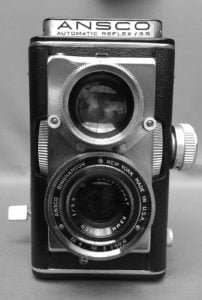
The easiest way to identify your Ansco is by the serial number. First model serial numbers start either with a 0 or 1. Rack the lens board all the way out (focused to the closest distance) and turn the camera over. The serial number is on the bottom of the lens board.
Representative serial numbers

Here are some serial numbers of first model Automatic Reflexes:
- 001308
- 002277 (with Heiland sync)
- 0001368
- 0001510 (with retrofit sync)
- 0001731 (with retrofit sync)
- 0001951
- 0001962 (with PC sync)
- 0002586 (with retrofit sync)
- 1004544
Missing flash sync
The first model, which officially launched November 7, 1947, lacked a flash synchronization post. Photographers who wished to take flash photos were expected to use a dual shutter release cable to trigger both the flash and shutter at the same time. At the time, it was a common solution. Camera-specific dual release cables were available for Leica rangefinders, for instance.

However, when Ansco introduced the second model in 1949, owners of the first model could send theirs in to be retrofitted with a flash sync post. The first model continued to be sold alongside the second albeit at a reduced price. You will find first model Automatic Reflexes with a flash sync post.
Heiland sync
Heiland, a company that made many kinds of flash units, also made synchronizers to allow older, non-sync cameras to work with the wide variety of flash units at the time. The Heiland Customflex, designed specifically for the Ansco Automatic Reflex, gave photographers the option to use flash with their first model Reflex.
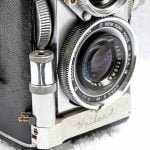
The synchronizer consisted of a battery-powered solenoid that was triggered from the flash unit. When the photographer pressed the button on his flash unit, the solenoid would fire the shutter on the camera.

Tripod socket may be a clue
The first model had a smaller socket insert, held with two rivets. There are some first model Automatic Reflexes with later style tripod sockets, perhaps made when both models were available.
|
Model 2
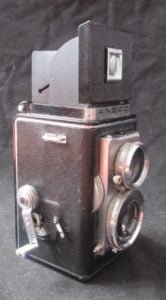
As with the first model, the easiest way to identify the second model Automatic Reflex is by the serial number. All second model serial numbers start with a 2.
Representative serial numbers
Here are some serial numbers of second model Automatic Reflexes:
- 2001071
- 2001218
- 2001474
- 2002037
- 2002207
- 2002800
- 2003050
- 2003481
- 2003866
- 2003871
Factory flash sync
From the photographer’s perspective, the addition of the flash sync post was the most salient feature of this model. It removed the need for a dual release cable and made it possible to easily shoot with on or off-camera flash.
Tripod socket
The tripod socket on the second model is beefier: the insert is physically larger in diameter and three rivets hold it in place.
